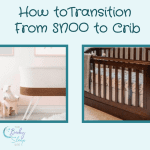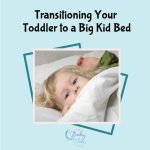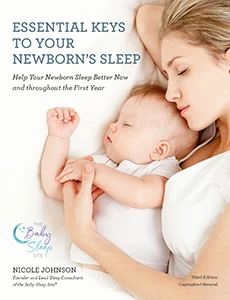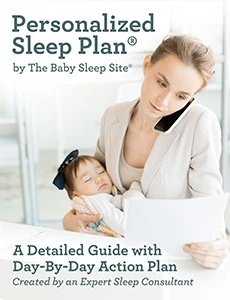
The most common age to move a baby to a crib is 6 months old, on average. However, there are several factors to consider when deciding when to transition your baby to a crib. This post will discuss these factors so you can decide the best time to move your baby to the crib and do it successfully. Let’s get to it!
Weight Limits of Bassinets
How long your baby sleeps in a bassinet will include a few factors, one of the biggest ones being their weight. Most bassinets have a weight limit that ranges from 15 to 35 pounds. Be sure to check your specific bassinet’s weight limit.
For example, the Arms Reach Bassinets all have an age recommendation of 5 months or when your child begins to push up on their hands and knees. Other bassinets have a suggested age and weight limit. For example, this Ingenuity Bassinet has a special feature that will work for babies up to 12 months of age (if your baby is 25 pounds or less). Smaller bassinets often have a weight limit of 15-20 pounds. So you will want to be careful to check your specific bassinet’s limitations. Be sure to stop using a bassinet when your baby is too heavy for it.
Sharing a Room
Another thing to consider when deciding when to transition your baby to a crib is whether you plan to continue sharing a room. If your baby’s crib is too large to fit in your room, then moving them to a crib might also mean moving them to a room that’s separate from you. That’s a big step!
The AAP recommends sharing a room but not a sleep space “for at least 6 months but preferably a year.” Therefore, if your baby is not yet 6+ months and the crib is in another room from yours, you should consider keeping the baby in the room with you for a bit longer…as long as it’s safe to do so. If your baby is already 6+ months old then they may be ready to sleep in their own room.
Babies are loud sleepers, so if your baby is keeping you awake at night but doesn’t need your attention, consider wearing earplugs. With earplugs, you will still hear your baby crying but not be woken up by every noise.
You May Also Be Interested In…
3 Things to Do When Baby Won’t Sleep in a Bedside Bassinet
SNOO: Is It Worth It?
Growth and Developmental Milestones
Even if your baby isn’t necessarily outgrowing the bassinet due to their weight, they might outgrow it developmentally. Some babies become mobile at a faster rate than other babies. That means they might be rolling over or pushing up on their hands and knees. One of my clients had a baby who started crawling at 6 months old. That’s very young!
(Note: If your baby isn’t mobile, try not to worry! My sons took a long time to crawl and now they are both teen athletes!)
So, when you’re considering when to move your baby to a crib, consider that it can be unsafe if they can sit up in a bassinet, and if you’re co-sleeping, it is unsafe once they can roll or crawl off the side of a bed.
Comfort of the Bassinet
Keep in mind that some babies simply don’t like bassinets. My second son was one of them. No matter what I did, he wouldn’t sleep in it for even 5 minutes. I tried warming the surface and putting him all the way to sleep, etc. but he would simply NOT sleep there! He seemed to sleep in his crib just fine, though. To this day, I still can’t tell you what he didn’t like about the bassinet. Perhaps it was the thinner mattress or how small it was. It’s hard to say but if your baby doesn’t seem to like it, maybe it’s just the bassinet! Therefore, your baby won’t sleep in the bassinet long. Most babies, however, sleep in a bassinet until 4 to 6 months old and then start sleeping in a crib.
The Bottom Line: When Should You Move Baby to a Crib?
The bottom line is you should move your baby to a crib when it’s unsafe to keep them in their current sleep space. You might want to move your baby for other reasons and that’s okay, too! Every situation is unique and you know your baby best. If your baby is nearing the 3-4-month old mark, I recommend you start working toward it so you don’t feel rushed. Babies change fast!
Now that you know a little bit about how to choose when to move baby to a crib, let’s talk about HOW to transition them!
How to Transition to a Crib: 5 Tips
How you transition your baby to a crib will also include several factors to consider. Here are 5 tips for a successful transition to the crib using the acronym S.L.E.E.P.:
- Spend time in the crib – You don’t want your baby’s first experience in the crib to be trying to fall asleep. And, you don’t want them to be surprised when they wake up in a strange place. You want them to feel comfortable in their sleep space so first spend NON-sleep time in it. You can play peek-a-boo, put them in the crib while you put away laundry with music playing, or let them look at a mobile.
- Lay them on their backs for safe sleep. This reduces the risk of SIDS. We can’t always make them stay on their backs but that’s the way they should start.
- Empty the crib so there are no loose blankets or toys in the crib. It’s considered a safety hazard unless your baby is a year or older.
- Ease into it by doing short sleep periods at first. Assuming it’s safe for them to sleep in their previous sleep space, consider working your way up to all sleep periods in the crib. For example, you might start with one nap a day or just bedtime in the crib. Then, when they wake up, you can use the old sleep space. Over a period of a few days to a couple of weeks, you can work your way up to more sleep periods.
- Persist through tough times because quite a few of us reject something new. But, after a while, we ask ourselves “Why didn’t I do this sooner?” Your baby might not like the crib, at first. It’s similar to sleeping in a hotel the first night on vacation. At first, the bed just doesn’t feel like our own. Once your baby spends more and more time in the crib, it will feel just like theirs!
You May Also Be Interested In…
How to Get Baby to Sleep in a Crib
Baby Standing in the Crib and Won’t Sleep: How to Handle
A Special Note for Co-Sleeping Families
If you are co-sleeping or bed-sharing, moving to a crib can be a much bigger step. Up until now, not only was your baby in a different bed, but they were also snuggled up to you and, many times, breastfeeding on and off all night. In this scenario, we often build in a few smaller “baby steps” into our Personalized Sleep Plans®. We sometimes have to change sleep associations before we move the baby or toddler into the crib. This is because when you change more than one variable at a time (how they fall asleep AND where they sleep), it is often met with even more protest and crying. Many families will give up due to the very intense reaction. A slower process is often more successful for some families for this reason. You might be interested in reading our article, How to Gently Transition Your Baby From Co-sleeping.
Baby Keeps Waking Up in the Crib
If your baby keeps waking up when you put them in the crib, that may be an entirely different issue. Babies wake for many reasons, including sleep regressions, sleep associations, and more. Be sure to download our free e-Book, 5 Ways to Help Your Child Sleep Through the Night to get started on a better night’s sleep or 7 Common Napping Mistakes to fix those short naps!








